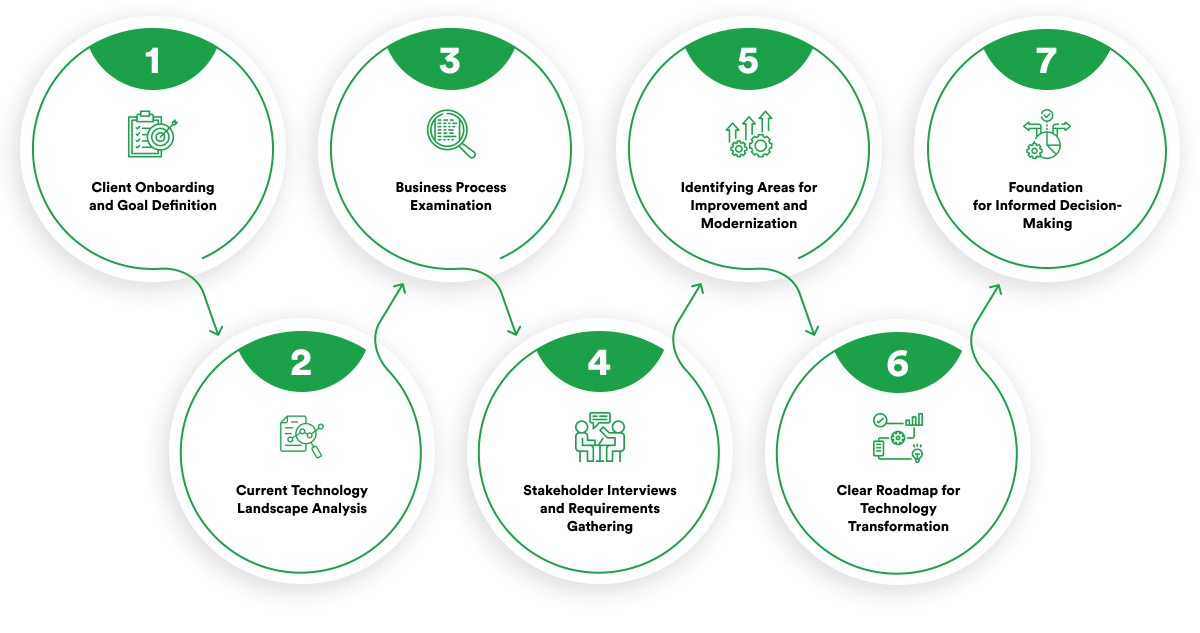
How to Roll Out an Innovation Project Within Your Company: Tips and Best Practices
This article will share three strategies to help R&D teams effectively and successfully implement new technologies.
According to Gartner, worldwide IT spending is projected to total $5.1 trillion in 2024, reflecting an 8% increase from 2023 and highlighting the growing investment in Digital Transformation efforts. Legacy systems, while foundational, often become barriers to innovation. They may need help integrating with modern technologies, posing significant security and operational efficiency risks. IBM reports that organizations with legacy systems spend up to 80% of their IT budgets on maintaining these outdated technologies. A thorough Technology Assessment helps businesses understand the strengths and weaknesses of their existing systems, facilitating informed decisions about upgrades and new technology investments.
This article explores the essential aspects of a corporate Strategic Technology Assessment initiative, focusing on how we do it for our customers at rinf.tech.
Some of the telltale signs that your organization badly needs a Strategic Technology Assessment include but aren’t limited to the following:
As such, the best time to consider conducting a Strategic Technology Assessment within your company is when you realize you lack a comprehensive understanding of your technology landscape, business processes and future goals.
Your key drivers for conducting a strategic Technology Assessment are as follows:
Conducting a strategic Technology Assessment facilitates early identification and mitigation of risks associated with outdated or inadequate technological infrastructure. By systematically monitoring the technological environment and its alignment with business operations, companies can proactively address issues before they escalate into costly problems. This not only safeguards against potential operational disruptions but also ensures that strategic decisions are made with a clear understanding of the technological risks involved, thereby maintaining the integrity and security of business processes.
Businesses can identify gaps and opportunities to enter new markets or offer new services by assessing current technology capabilities. For instance, adopting advanced analytics can provide deeper market insights, enabling better decision-making.
Staying competitive requires continuous innovation. Technology Assessment helps highlight areas where new technologies can streamline operations, improve customer experiences, and enhance competitiveness.
A strategic Technology Assessment ensures that your organization’s existing technological stack is robust enough to meet future market demands. This involves evaluating the capacity and capabilities of current technologies to support upcoming business initiatives and growth. If gaps are identified, the assessment provides critical insights into necessary upgrades or new technology implementations needed to sustain and scale operations effectively. This proactive approach helps in adapting to market changes and customer expectations efficiently.
By conducting a comprehensive Technology Assessment, organizations can develop a clear and achievable technology transformation roadmap. This roadmap outlines strategic steps to transition from current technological states to more advanced and effective systems. It includes timelines, resource allocations, and milestones that guide the entire transformation process. This structured plan helps ensure that technology upgrades and implementations are aligned with business objectives, making them manageable and successful in enhancing overall business performance and agility.
New technologies can drive efficiency, cost savings, and improved performance. For instance, cloud computing has become a critical enabler of digital transformation, offering scalable and flexible resources that can reduce IT costs considerably while increasing agility and scalability. According to a study by Flexera, 93% of enterprises have a multi-cloud strategy, highlighting the widespread adoption of cloud solutions to enhance operational efficiency. Moreover, Artificial Intelligence and Machine Learning can significantly improve decision-making processes and automation, with AI expected to contribute $15.7 trillion to the global economy by 2030.
While new technologies offer substantial benefits, they also have risks like integration challenges and data migration issues. For example, IT leaders can experience data migration failures during cloud transitions. These failures can result in data loss, increased costs, and project delays. However, a thorough Technology Assessment can identify these risks early, allowing businesses to develop mitigation strategies and ensure smoother transitions. This early identification instills a sense of security and confidence in the decision-making process, knowing that potential risks are under control.
A Technology Assessment allows for comparison of maintaining and upgrading existing systems to adopt new technologies. This helps businesses make cost-effective and strategic decisions aligned with their long-term goals.
It is crucial to ensure that technology investments support the company’s vision and objectives. A Technology Assessment aligns technology choices with business goals, enhancing the overall strategic direction. Misalignment between technology and business strategies can delay growth, thus emphasizing the importance of a cohesive approach. This alignment reassures the business leaders and ensures that every technological decision aligns with the company’s vision, fostering a sense of unity and shared purpose.
Future-proofing involves selecting technologies that can evolve with the business. This includes evaluating software and hardware that offer scalability and flexibility. Gartner predicts that by 2025, 75% of organizations will undergo IT transformation, driven by the need for scalable and adaptable technology solutions. Such transformations ensure that businesses are well-equipped to handle future demands and growth.
New technologies often require new skills. A Technology Assessment includes planning for workforce training and development to ensure that employees can effectively use and manage new systems. According to a report by Deloitte, 74% of companies plan to upskill or reskill their workforce to better adapt to new technologies, highlighting the importance of continuous learning and development. This approach not only enhances employee capabilities but also ensures that the organization can fully leverage its technology investments, emphasizing the value of your ongoing professional growth.
Conducting a Technology Assessment is a structured process that involves several key steps to ensure a thorough evaluation of your current technology landscape and strategic planning for future investments. Here’s how we conduct a strategic Technology Assessment for our customers at rinf.tech.
We start by engaging in thorough discussions with key stakeholders to understand your business objectives. This phase involves high-level conversations and detailed data collection on your current technology landscape. Identifying pain points, operational inefficiencies, and strategic goals that your technology should support is essential. Clear communication during this stage helps build a strong foundation for the assessment process, ensuring all relevant perspectives are considered.
Furthermore, defining specific goals and expectations for the Technology Assessment is vital. We outline what success looks like, including the expected outcomes and metrics. For instance, if one of the goals is to reduce IT maintenance costs, quantify this target. You can track progress and make adjustments as needed by setting measurable objectives. This clarity ensures all stakeholders understand the project’s aims and remain aligned throughout the process.
Once the goals are defined, the next step is to comprehensively review your existing technology infrastructure. This involves a detailed evaluation of your current applications and platforms, focusing on their architecture, scalability, and performance.
Identifying legacy systems, potential bottlenecks, and areas of technical debt is crucial for understanding the client’s challenges. Legacy systems often inhibit agility and innovation, while bottlenecks can slow operations and reduce efficiency. Technical debt, which includes outdated or suboptimal code and systems, can lead to increased maintenance costs and reduced flexibility.
Evaluating the security posture and compliance status of the technology stack is also vital to ensure that the organization is protected against cyber threats and adheres to relevant regulations.
Documenting findings and presenting an overview of the current state provides a clear baseline for measuring progress. This documentation should be thorough and detailed, highlighting strengths and weaknesses in the existing technology environment. By thoroughly evaluating these findings, we can ensure that all stakeholders understand the current circumstances and are aligned on the areas that need improvement.
Understanding core business processes through collaboration with business analysts and process owners is essential. Business processes form the backbone of any organization, and learning their intricacies is crucial for identifying optimization opportunities. Mapping out end-to-end workflows, including dependencies and integration points, offers a comprehensive view of how different processes interact and where potential improvements lie.
Evaluating the efficiency, agility, and adaptability of existing processes helps pinpoint pain points, redundancies, and areas for optimization. Efficient processes are vital for maintaining competitiveness, while agility and adaptability enable responses to changing market conditions. Organizations can enhance operational efficiency and support their strategic goals by addressing these areas.
A detailed analysis of the current business process landscape lays the groundwork for informed decisions on process improvements. This analysis helps us highlight the strengths and weaknesses of current processes and offer optimization recommendations.
Conducting interviews with key stakeholders (including executives, IT personnel, and end-users) is crucial for gathering comprehensive requirements for the Technology Assessment. These interviews provide valuable insights into different organizational parts’ needs, challenges, and expectations. Gathering requirements from a mixed group ensures the assessment considers all relevant perspectives and addresses specific needs.
Identifying user experience requirements and gathering feedback on existing systems ensures the technology assessment improves overall user experience. User feedback is critical for identifying system shortcomings and understanding how technology can better support business processes. Gathering insights on future business initiatives and potential tech needs allows our Technology Assessment Team to consider long-term goals and ensure the recommendations support the organization’s growth.
Compiling a comprehensive set of requirements guides the assessment, ensuring the recommendations address the organization’s most critical needs. This requirement should be detailed and specific, providing a clear roadmap for our Assessment Team. Presenting these requirements to stakeholders and ensuring their alignment with business objectives establishes a solid foundation for a successful technology assessment.
We analyze the data collected during the assessment to identify areas that require improvement in your technology landscape. This involves a detailed review of the findings from the previous phases, focusing on areas that pose the greatest challenges or offer the most significant opportunities for improvement. We prioritize these findings based on impact, feasibility, and alignment with your business goals. For example, addressing a critical security vulnerability may take precedence over adding a new feature that offers marginal benefits.
Our Assessment Team evaluates opportunities for modernization and innovation, considering how emerging technologies can enhance your operations. This might include adopting cloud solutions to improve scalability or implementing AI-driven analytics for better decision-making. By focusing on initiatives that offer the highest value and are most feasible, we can develop a targeted and effective improvement strategy that drives your business forward.
Developing a strategic roadmap is essential for guiding your technology transformation. This roadmap should outline the steps for implementing the recommended changes, including milestones and timelines for each project phase. A well-structured roadmap ensures that all stakeholders understand the sequence of activities and the expected outcomes at each stage. It also helps allocate resources effectively and manage the project timeline.
We align the roadmap with the identified improvement areas and modernization strategies to ensure it addresses the prioritized findings and supports your overall business strategy. We then define clear milestones and timelines to monitor progress and keep the project on track. For instance, we set specific deadlines for completing each phase, such as system upgrades or user training sessions. A clear and thorough roadmap is crucial for ensuring a successful digital transformation.
Finally, our Team compiles a comprehensive report summarizing the assessment findings, including identified improvement areas and the proposed roadmap for transformation. This report provides actionable insights and recommendations, helping your organization make informed decisions about technology investments. Presenting the findings clearly and concisely ensures that decision-makers understand the motivation behind the recommendations and can allocate resources appropriately.
Regularly reviewing and monitoring the implementation process is essential to verify that the new technologies align with your business goals and deliver the expected benefits. We therefore establish a feedback loop to assess the effectiveness of the implemented solutions and make necessary adjustments. By focusing on informed decision-making, you can ensure that your technology investments drive sustained growth and competitive advantage.

Technology Assessment is a pivotal element for successful digital transformation projects. It provides a comprehensive evaluation of a company’s current technology infrastructure, identifying strengths, weaknesses, and opportunities for improvement. As businesses navigate the complexities of digital transformation, a strategic Technology Assessment serves as a roadmap, guiding them through the intricacies of integrating new technologies while mitigating potential risks.
Technology Assessment is not just about addressing current gaps, it’s about future-proofing your strategies. By identifying and addressing gaps in your current technology landscape, it helps you develop a strategy that supports scalability and adaptability, crucial for sustaining success in an ever-evolving digital environment.
To achieve these goals, partnering with an experienced service provider is essential. We at rinf.tech can help your business complete its strategic Technology Assessment and embark on a transformative journey toward greater agility, innovation, and competitive advantage.

This article will share three strategies to help R&D teams effectively and successfully implement new technologies.

This article explores interesting machine learning projects that companies in various sectors can launch to gain a significant competitive advantage in a highly saturated business landscape.

This article explores top use cases of integrating ChatGPT into business strategies and operations across multiple industries and domains.